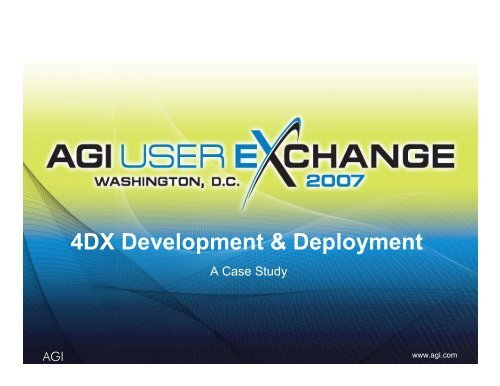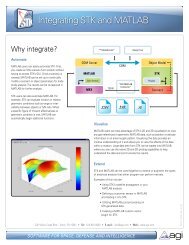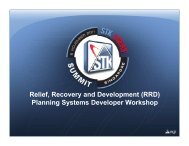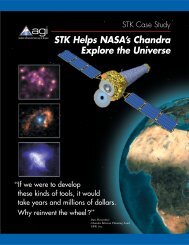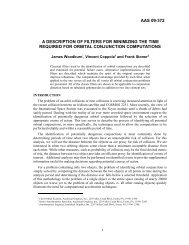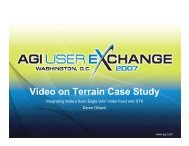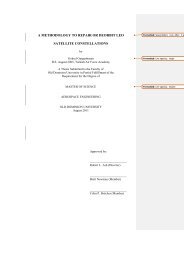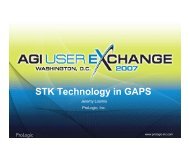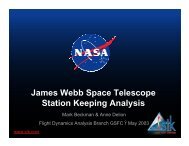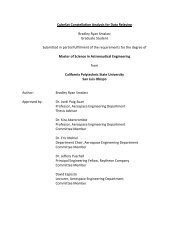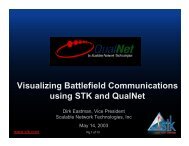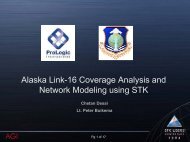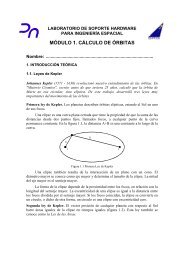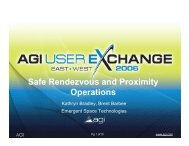4DX Development & Deployment - AGI
4DX Development & Deployment - AGI
4DX Development & Deployment - AGI
You also want an ePaper? Increase the reach of your titles
YUMPU automatically turns print PDFs into web optimized ePapers that Google loves.
<strong>4DX</strong> <strong>Development</strong> & <strong>Deployment</strong>A Case Study<strong>AGI</strong>www.agi.com
Outline• Business case• A subset of current capabilities• Lessons learned<strong>AGI</strong>Pg 2 of 14www.agi.com
Business Case• Environment– Changing missions and mission focus– Changing requirements– Limited budgets• Needs to address– Provide efficient operations– Address shortened learning curves– Provide systematic and repeatable processes– Address multiple isolated working environments withsimilar needs<strong>AGI</strong>Pg 3 of 14www.agi.com
Business Case• <strong>AGI</strong>’s <strong>4DX</strong> Solution– Allows quick development of custom designs– Minimizes code development– Efficiently captures operator’s work flow– Provides an efficient, repeatable and reliable solution• The OPS tool suite is successfully deployed in severaloperational environments<strong>AGI</strong>Pg 4 of 14www.agi.com
Controlled Environment• Controlled and monitoredoperational environment– Controlled access– All activities archived– Only reviewed reports arearchived– Automatic archive at log off– All sessions can be recreated<strong>AGI</strong>Pg 5 of 14www.agi.com
Common GUI for All ToolsTop Bar: Reserved for General ApplicationsLeft SideBarSpecificProcessIconsRight SideBar2D/3DGraphicswindowcontrols<strong>AGI</strong>Bottom Bar: Standard animation controlsPg 6 of 14www.agi.com
Collision Avoidance GUIOPS’sProcess Icon:COLA<strong>AGI</strong>OPSCOLA Window09 Jul 2007 20:03:44AdvCAT-COLAAdvCAT-COLAPrimary Vehicle:GEORef.saCLOSE ---------------------------APPROACH ENCOUNTER WARNINGS---------------------------------Object NameDate/Time Span of Run09 Jul 2007 SSCStart:19:56:4308 Jul 2007 00:00:00.000AdvCAT-COLAEnd: 09 Jul Time 2007 In 12:00:00.000(UTCG)Time Out (UTCG)Uncertainty Ellipsoid Min Separation Surface-to-Surface (km)Separation DistanceScreening Threshold Min Range Close = 400.0 Approach (km)Definition------------------------------------------------------------------------------------Collision Probability (Analytic)Advanced NOTE: CAT Relative object: COLAGeometry Nomenclature: e.g. SAT#2 w.r.t. SAT#1--------------------------------Close Approach Normal: Threshold: 400.000000 +U = SAT#2 (km)ABOVE SAT#1Close Approach GEOM300.saTangential:Time Interval: +V 8 Jul = SAT#2 2007 00:00:00.000 AHEAD of SAT#1to 9 Jul 2007 12:00:00.00099999Cross-Track: +W = SAT#2 LEFT of SAT#18 Jul 2007 00:00:00.000Approach Angle:0 deg = OvertakingSettings8 Jul 2007 180 02:15:47.550deg = Head-On-------------------------------------------------298.969637Out of Date Filter Yaw is locates ON. Time projection is 30.000000 299.969637of daysmajor axis onto UV plane from VApo Peri FilterPitch is ON. locates Pad is major 30.000000 axis 0.0000e+000from (km)UV planePath FilterRoll is locates ON. Pad minor is 30.000000 axis from (km)WTime Filteris ON. Pad is 30.000000 (km)tle 26402*********************************************************MaxSampleStepSizeis 26402300.000000secsSatellite #1: 899999Jul 2007GEORef.saMinSampleStepSizeis 00:00:00.000Satellite #2: 1.000000secs99999GEOM300.sa9 Jul 2007 12:00:00.000Range (km) Date 241.130283TimeName 299.97 Status 08 Jul Type 2007 Tangential 00:00:00.000 245.123016(km) THRESHOLD Cross-Track ENTRY(km) Normal (km)--------- ---------- 299.97 08 -------- Jul 2007 --------------- 00:00:00.000 0.0000e+000CLOSEST ---------------- APPROACH-----------GEORef.sa Found 402.76 File 08 Sat Jul File 2007 02:15:47.550 2.000000 THRESHOLD 1.000000 EXIT0.500000Relative GEOP300.saPOSITION at Time of Closest Approach: ( 299.97 km)99999SAT#2 w.r.t. SAT#1SAT#1 w.r.t. SAT#2Name Status Type Tangential (km) Cross-Track (km) Normal (km)Normal 8 Jul [U]: 2007 00:00:00.000-299.97 km 299.97 km--------------- Tangential ---------- [V]: -------- 0.00 --------------- km ---------------- -0.00 km-----------stkSatDbAll.tce 8 Jul 2007 02:17:11.209Cross-Track Found File [W]: TleFile 0.00 km 2.000000 -0.00 km1.000000 0.500000GEOM300.sa Found File Sat File 299.0303632.000000 1.000000 0.500000GEOP300.sa Relative Found VELOCITY File Sat Time File 300.030363of Closest 2.000000 Approach: ( 0.01 1.000000 km/s)0.500000GEORef.sa Approach Found File Angle Sat = 0.00 File 0.0000e+000deg2.000000 1.000000 0.500000Moly.sa Found File Sat SAT#2 File w.r.t. SAT#12.000000 SAT#1 w.r.t. 1.000000 SAT#20.500000Normal [U]: -0.00 km/s 0.00 km/stle Tangential 27426[V]: 0.01 km/s -0.01 km/s27426Cross-Track [W]: -0.00 km/s 0.00 km/sClose Approach Report by Min Sep--------------------------------8 Jul 2007 00:00:00.0001-Sigma Position 9 Jul Uncertainties:2007 12:00:00.000SAT#1SAT#2Primary Vehicle:Time GEORef.safrom Epoch: 63.5386720.0 days 0.0 days---------------------------Normal [U]: 67.2782140.50 km 0.50 kmTangential [V]: 4.4491e-2012.00 km 2.00 kmObject Name Cross-Track Time In (UTCG) [W]: Time Out 1.00 (UTCG) km Min Separation 1.00 (km) Min Range (km)----------- ----------------------- ----------------------- ------------------- --------------tle 27501 8 Jul 2007 Major 00:00:00.000 Axis : 9 Jul 2007 2.00 12:00:00.000 km 2.00 9.152142 km10.233289tle 18446 8 Jul 2007 Middle 02:05:15.457 Axis : 8 Jul 2007 1.00 02:25:56.231 km 1.00 59.914008 km61.765049tle 27426 8 Jul 2007 Minor 00:00:00.000 Axis : 9 Jul 2007 0.50 12:00:00.000 km 0.50 63.538672 km67.278214tle 28935 8 Jul 2007 00:00:00.000 9 Jul 2007 12:00:00.000 131.204526 135.129175tle 23639 8 Jul 2007 04:37:19.477 Yaw : 8 Jul 2007 0.000 05:04:41.460 deg 0.000 240.736513 deg243.441681tle 26402 8 Jul 2007 00:00:00.000 Pitch : 9 Jul 2007 0.000 12:00:00.000 deg 0.000 241.130283 deg245.123016tle 27717 8 Jul 2007 23:23:35.706 Roll : 8 Jul 2007 0.000 23:30:06.995 deg 0.000 291.363749 deg293.327157GEOM300.sa 8 Jul 2007 00:00:00.000 8 Jul 2007 02:15:47.550 298.969637 299.969637GEOP300.sa Corresponding 8 Jul 2007 00:00:00.000 Locations 8 Jul within 2007 02:17:11.209 Respective Error 299.030363 Ellipsoids:300.030363tle 18446 9 Jul 2007 02:06:59.243 SAT#2 9 Jul 2007 w.r.t. 02:17:48.275 SAT#1SAT#1 341.871463 w.r.t. SAT#2345.805426599.94 sigma 599.94 sigmaOPSCustomFormattedReportsPg 8 of 14• OperationallyOrientated– Accepts only validephemeris– Errors flagged &displayed– Automaticallydisplays events– Archivesautomaticallywww.agi.com
Pg 10 of 14<strong>AGI</strong>www.agi.comRF Analysis Design & GUIAs an introduction, let me explain the work I have been performing for AFSPC/XPX and that I expect to continue to beperforming as a TASC employee. In essence, there are three areas of effort and all three are mutuallysupportive and interrelated. Further, it is expected that I will expand the support in the Special Studies areasthat I began while at MITRE. The three areas of this work program are:IPP analysis for AFSPC Mission Areas:1. Perform model enhancements and configuration control of the AFSPC AeroSpace Integrated InvestmentSoftware (ASIIS) optimization model.2. Adapt the optimization model to the ever-changing AFSPC analysis requirements.3. Implement the AFSPC mission-wide planning process.a. Provide architecture solution sets for input to the AFSPC Mission Area Plan (MAP) and 25-year Road Mapusing the ASIIS optimization model.b. Provide support to the POM deliberation process.c. Ensure that the MAP and the POM results are consistent.IPP analysis for Special Studies:1. Prepare the MAP Annex for multiple customers.2. Generate and modify, where necessary, measures to accommodate concept scoring and architectureoptimization.3. Perform optimization analysis across AFSPC and other customers’ needs and concepts.4. Perform current capability and future system analysis to supportSpecial Programs planning.Special Programs Planning Process:1. Enhance modeling capabilities using a variety of sophisticated software tools.2. Support multiple customers with technical analysis to includea. Detailed RF models.b. Orbital dynamics and time-dependent geometric relationship modelingc. Contingency and “what-if” modeling.1. Provide collaborative planning analysis between AFSPC and Special Programs.4. The above three areas of analysis and modeling drive the software and hardware requirements specified below.5. Finally, let me say that in the past I have provided this support to AFSPC/XPX and the Special6. Programs planning directorate within the time constraints that have been placed on me. The customers areexpecting that I will continue with this on-time support as a member of the TASC7. Team. The following minimal set of software and hardware requirements, plus the necessary accesses, willensure that the objectives can be met.8. Software Requirements:9. AeroSpace Integrated Investment Software (ASIIS):10. ASIIS is a mixed integer program (MIP) optimization model designed to assist AFASPC in the development of aninvestment strategy and roadmap for the future. That is, it provides senior leaders with the solution sets,possible systems to purchase, so that AFSPC will the achieve mission goals.11. Why is this an optimization problem? Consider that AFSPC has about 200+ systems and concepts to consider (for only theCounter Space mission area). Each of these systems have several possible start and stop dates, they provideutility against one or more tasks (each task having aAs an introduction, let me explain the work I have been performing for AFSPC/XPX and that I expect to continue to beperforming as a TASC employee. In essence, there are three areas of effort and all three are mutuallysupportive and interrelated. Further, it is expected that I will expand the support in the Special Studies areasthat I began while at MITRE. The three areas of this work program are:IPP analysis for AFSPC Mission Areas:1. Perform model enhancements and configuration control of the AFSPC AeroSpace Integrated InvestmentSoftware (ASIIS) optimization model.2. Adapt the optimization model to the ever-changing AFSPC analysis requirements.3. Implement the AFSPC mission-wide planning process.a. Provide architecture solution sets for input to the AFSPC Mission Area Plan (MAP) and 25-year Road Mapusing the ASIIS optimization model.b. Provide support to the POM deliberation process.c. Ensure that the MAP and the POM results are consistent.IPP analysis for Special Studies:1. Prepare the MAP Annex for multiple customers.2. Generate and modify, where necessary, measures to accommodate concept scoring and architectureoptimization.3. Perform optimization analysis across AFSPC and other customers’ needs and concepts.4. Perform current capability and future system analysis to supportSpecial Programs planning.Special Programs Planning Process:1. Enhance modeling capabilities using a variety of sophisticated software tools.2. Support multiple customers with technical analysis to includea. Detailed RF models.b. Orbital dynamics and time-dependent geometric relationship modelingc. Contingency and “what-if” modeling.1. Provide collaborative planning analysis between AFSPC and Special Programs.4. The above three areas of analysis and modeling drive the software and hardware requirements specified below.5. Finally, let me say that in the past I have provided this support to AFSPC/XPX and the Special6. Programs planning directorate within the time constraints that have been placed on me. The customers areexpecting that I will continue with this on-time support as a member of the TASC7. Team. The following minimal set of software and hardware requirements, plus the necessary accesses, willensure that the objectives can be met.8. Software Requirements:9. AeroSpace Integrated Investment Software (ASIIS):10. ASIIS is a mixed integer program (MIP) optimization model designed to assist AFASPC in the development of aninvestment strategy and roadmap for the future. That is, it provides senior leaders with the solution sets,possible systems to purchase, so that AFSPC will the achieve mission goals.11. Why is this an optimization problem? Consider that AFSPC has about 200+ systems and concepts to consider (for only theCounter Space mission area). Each of these systems have several possible start and stop dates, they provideutility against one or more tasks (each task having aAs an introduction, let me explain the work I have been performing for AFSPC/XPX and that I expect to continue to beperforming as a TASC employee. In essence, there are three areas of effort and all three are mutuallysupportive and interrelated. Further, it is expected that I will expand the support in the Special Studies areasthat I began while at MITRE. The three areas of this work program are:IPP analysis for AFSPC Mission Areas:1. Perform model enhancements and configuration control of the AFSPC AeroSpace Integrated InvestmentSoftware (ASIIS) optimization model.2. Adapt the optimization model to the ever-changing AFSPC analysis requirements.3. Implement the AFSPC mission-wide planning process.a. Provide architecture solution sets for input to the AFSPC Mission Area Plan (MAP) and 25-year Road Mapusing the ASIIS optimization model.b. Provide support to the POM deliberation process.c. Ensure that the MAP and the POM results are consistent.IPP analysis for Special Studies:1. Prepare the MAP Annex for multiple customers.2. Generate and modify, where necessary, measures to accommodate concept scoring and architectureoptimization.3. Perform optimization analysis across AFSPC and other customers’ needs and concepts.4. Perform current capability and future system analysis to support Special Programs planning.Special Programs Planning Process:1. Enhance modeling capabilities using a variety of sophisticated software tools.2. Support multiple customers with technical analysis to includea. Detailed RF models.b. Orbital dynamics and time-dependent geometric relationship modelingc. Contingency and “what-if” modeling.1. Provide collaborative planning analysis between AFSPC and Special Programs.4. The above three areas of analysis and modeling drive the software and hardware requirements specified below.5. Finally, let me say that in the past I have provided this support to AFSPC/XPX and the Special6. Programs planning directorate within the time constraints that have been placed on me. The customers areexpecting that I will continue with this on-time support as a member of the TASC7. Team. The following minimal set of software and hardware requirements, plus the necessary accesses, willensure that the objectives can be met.8. Software Requirements:9. AeroSpace Integrated Investment Software (ASIIS):10. ASIIS is a mixed integer program (MIP) optimization model designed to assist AFASPC in the development of aninvestment strategy and roadmap for the future. That is, it provides senior leaders with the solution sets,possible systems to purchase, so that AFSPC will the achieve mission goals.11. Why is this an optimization problem? Consider that AFSPC has about 200+ systems and concepts to consider (for only theCounter Space mission area). Each of these systems have several possible start and stop dates, they provideutility against one or more tasks (each task having aAs an introduction, let me explain the work I have been performing for AFSPC/XPX and that I expect to continue to beperforming as a TASC employee. In essence, there are three areas of effort and all three are mutuallysupportive and interrelated. Further, it is expected that I will expand the support in the Special Studies areasthat I began while at MITRE. The three areas of this work program are:IPP analysis for AFSPC Mission Areas:1. Perform model enhancements and configuration control of the AFSPC AeroSpace Integrated InvestmentSoftware (ASIIS) optimization model.2. Adapt the optimization model to the ever-changing AFSPC analysis requirements.3. Implement the AFSPC mission-wide planning process.a. Provide architecture solution sets for input to the AFSPC Mission Area Plan (MAP) and 25-year Road Mapusing the ASIIS optimization model.b. Provide support to the POM deliberation process.c. Ensure that the MAP and the POM results are consistent.IPP analysis for Special Studies:1. Prepare the MAP Annex for multiple customers.2. Generate and modify, where necessary, measures to accommodate concept scoring and architectureoptimization.3. Perform optimization analysis across AFSPC and other customers’ needs and concepts.4. Perform current capability and future system analysis to supportSpecial Programs planning.Special Programs Planning Process:1. Enhance modeling capabilities using a variety of sophisticated software tools.2. Support multiple customers with technical analysis to includea. Detailed RF models.b. Orbital dynamics and time-dependent geometric relationship modelingc. Contingency and “what-if” modeling.1. Provide collaborative planning analysis between AFSPC and Special Programs.4. The above three areas of analysis and modeling drive the software and hardware requirements specified below.5. Finally, let me say that in the past I have provided this support to AFSPC/XPX and the Special6. Programs planning directorate within the time constraints that have been placed on me. The customers areexpecting that I will continue with this on-time support as a member of the TASC7. Team. The following minimal set of software and hardware requirements, plus the necessary accesses, willensure that the objectives can be met.8. Software Requirements:9. AeroSpace Integrated Investment Software (ASIIS):10. ASIIS is a mixed integer program (MIP) optimization model designed to assist AFASPC in the development of aninvestment strategy and roadmap for the future. That is, it provides senior leaders with the solution sets,possible systems to purchase, so that AFSPC will the achieve mission goals.11. Why is this an optimization problem? Consider that AFSPC has about 200+ systems and concepts to consider (for only theCounter Space mission area). Each of these systems have several possible start and stop dates, they provideutility against one or more tasks (each task having aAs an introduction, let me explain the work I have been performing for AFSPC/XPX and that I expect to continue to beperforming as a TASC employee. In essence, there are three areas of effort and all three are mutuallysupportive and interrelated. Further, it is expected that I will expand the support in the Special Studies areasthat I began while at MITRE. The three areas of this work program are:IPP analysis for AFSPC Mission Areas:1. Perform model enhancements and configuration control of the AFSPC AeroSpace Integrated InvestmentSoftware (ASIIS) optimization model.2. Adapt the optimization model to the ever-changing AFSPC analysis requirements.3. Implement the AFSPC mission-wide planning process.a. Provide architecture solution sets for input to the AFSPC Mission Area Plan (MAP) and 25-year Road Mapusing the ASIIS optimization model.b. Provide support to the POM deliberation process.c. Ensure that the MAP and the POM results are consistent.IPP analysis for Special Studies:1. Prepare the MAP Annex for multiple customers.2. Generate and modify, where necessary, measures to accommodate concept scoring and architectureoptimization.3. Perform optimization analysis across AFSPC and other customers’ needs and concepts.4. Perform current capability and future system analysis to support Special Programs planning.Special Programs Planning Process:1. Enhance modeling capabilities using a variety of sophisticated software tools.2. Support multiple customers with technical analysis to includea. Detailed RF models.b. Orbital dynamics and time-dependent geometric relationship modelingc. Contingency and “what-if” modeling.1. Provide collaborative planning analysis between AFSPC and Special Programs.4. The above three areas of analysis and modeling drive the software and hardware requirements specified below.5. Finally, let me say that in the past I have provided this support to AFSPC/XPX and the Special6. Programs planning directorate within the time constraints that have been placed on me. The customers areexpecting that I will continue with this on-time support as a member of the TASC7. Team. The following minimal set of software and hardware requirements, plus the necessary accesses, willensure that the objectives can be met.8. Software Requirements:9. AeroSpace Integrated Investment Software (ASIIS):10. ASIIS is a mixed integer program (MIP) optimization model designed to assist AFASPC in the development of aninvestment strategy and roadmap for the future. That is, it provides senior leaders with the solution sets,possible systems to purchase, so that AFSPC will the achieve mission goals.11. Why is this an optimization problem? Consider that AFSPC has about 200+ systems and concepts to consider (for only theCounter Space mission area). Each of these systems have several possible start and stop dates, they provideutility against one or more tasks (each task having aAs an introduction, let me explain the work I have been performing for AFSPC/XPX and that I expect to continue to beperforming as a TASC employee. In essence, there are three areas of effort and all three are mutuallysupportive and interrelated. Further, it is expected that I will expand the support in the Special Studies areasthat I began while at MITRE. The three areas of this work program are:IPP analysis for AFSPC Mission Areas:1. Perform model enhancements and configuration control of the AFSPC AeroSpace Integrated InvestmentSoftware (ASIIS) optimization model.2. Adapt the optimization model to the ever-changing AFSPC analysis requirements.3. Implement the AFSPC mission-wide planning process.a. Provide architecture solution sets for input to the AFSPC Mission Area Plan (MAP) and 25-year Road Mapusing the ASIIS optimization model.b. Provide support to the POM deliberation process.c. Ensure that the MAP and the POM results are consistent.IPP analysis for Special Studies:1. Prepare the MAP Annex for multiple customers.2. Generate and modify, where necessary, measures to accommodate concept scoring and architectureoptimization.3. Perform optimization analysis across AFSPC and other customers’ needs and concepts.4. Perform current capability and future system analysis to supportSpecial Programs planning.Special Programs Planning Process:1. Enhance modeling capabilities using a variety of sophisticated software tools.2. Support multiple customers with technical analysis to includea. Detailed RF models.b. Orbital dynamics and time-dependent geometric relationship modelingc. Contingency and “what-if” modeling.1. Provide collaborative planning analysis between AFSPC and Special Programs.4. The above three areas of analysis and modeling drive the software and hardware requirements specified below.5. Finally, let me say that in the past I have provided this support to AFSPC/XPX and the Special6. Programs planning directorate within the time constraints that have been placed on me. The customers areexpecting that I will continue with this on-time support as a member of the TASC7. Team. The following minimal set of software and hardware requirements, plus the necessary accesses, willensure that the objectives can be met.8. Software Requirements:9. AeroSpace Integrated Investment Software (ASIIS):10. ASIIS is a mixed integer program (MIP) optimization model designed to assist AFASPC in the development of aninvestment strategy and roadmap for the future. That is, it provides senior leaders with the solution sets,possible systems to purchase, so that AFSPC will the achieve mission goals.11. Why is this an optimization problem? Consider that AFSPC has about 200+ systems and concepts to consider (for only theCounter Space mission area). Each of these systems have several possible start and stop dates, they provideutility against one or more tasks (each task having aAs an introduction, let me explain the work I have been performing for AFSPC/XPX and that I expect to continue to beperforming as a TASC employee. In essence, there are three areas of effort and all three are mutuallysupportive and interrelated. Further, it is expected that I will expand the support in the Special Studies areasthat I began while at MITRE. The three areas of this work program are:IPP analysis for AFSPC Mission Areas:1. Perform model enhancements and configuration control of the AFSPC AeroSpace Integrated InvestmentSoftware (ASIIS) optimization model.2. Adapt the optimization model to the ever-changing AFSPC analysis requirements.3. Implement the AFSPC mission-wide planning process.a. Provide architecture solution sets for input to the AFSPC Mission Area Plan (MAP) and 25-year Road Mapusing the ASIIS optimization model.b. Provide support to the POM deliberation process.c. Ensure that the MAP and the POM results are consistent.IPP analysis for Special Studies:1. Prepare the MAP Annex for multiple customers.2. Generate and modify, where necessary, measures to accommodate concept scoring and architectureoptimization.3. Perform optimization analysis across AFSPC and other customers’ needs and concepts.4. Perform current capability and future system analysis to supportSpecial Programs planning.Special Programs Planning Process:1. Enhance modeling capabilities using a variety of sophisticated software tools.2. Support multiple customers with technical analysis to includea. Detailed RF models.b. Orbital dynamics and time-dependent geometric relationship modelingc. Contingency and “what-if” modeling.1. Provide collaborative planning analysis between AFSPC and Special Programs.4. The above three areas of analysis and modeling drive the software and hardware requirements specified below.5. Finally, let me say that in the past I have provided this support to AFSPC/XPX and the Special6. Programs planning directorate within the time constraints that have been placed on me. The customers areexpecting that I will continue with this on-time support as a member of the TASC7. Team. The following minimal set of software and hardware requirements, plus the necessary accesses, willensure that the objectives can be met.8. Software Requirements:9. AeroSpace Integrated Investment Software (ASIIS):10. ASIIS is a mixed integer program (MIP) optimization model designed to assist AFASPC in the development of aninvestment strategy and roadmap for the future. That is, it provides senior leaders with the solution sets,possible systems to purchase, so that AFSPC will the achieve mission goals.11. Why is this an optimization problem? Consider that AFSPC has about 200+ systems and concepts to consider (for only theCounter Space mission area). Each of these systems have several possible start and stop dates, they provideutility against one or more tasks (each task having aAs an introduction, let me explain the work I have been performing for AFSPC/XPX and that I expect to continue to beperforming as a TASC employee. In essence, there are three areas of effort and all three are mutuallysupportive and interrelated. Further, it is expected that I will expand the support in the Special Studies areasthat I began while at MITRE. The three areas of this work program are:IPP analysis for AFSPC Mission Areas:1. Perform model enhancements and configuration control of the AFSPC AeroSpace Integrated InvestmentSoftware (ASIIS) optimization model.2. Adapt the optimization model to the ever-changing AFSPC analysis requirements.3. Implement the AFSPC mission-wide planning process.a. Provide architecture solution sets for input to the AFSPC Mission Area Plan (MAP) and 25-year Road Mapusing the ASIIS optimization model.b. Provide support to the POM deliberation process.c. Ensure that the MAP and the POM results are consistent.IPP analysis for Special Studies:1. Prepare the MAP Annex for multiple customers.2. Generate and modify, where necessary, measures to accommodate concept scoring and architectureoptimization.3. Perform optimization analysis across AFSPC and other customers’ needs and concepts.4. Perform current capability and future system analysis to support Special Programs planning.Special Programs Planning Process:1. Enhance modeling capabilities using a variety of sophisticated software tools.2. Support multiple customers with technical analysis to includea. Detailed RF models.b. Orbital dynamics and time-dependent geometric relationship modelingc. Contingency and “what-if” modeling.1. Provide collaborative planning analysis between AFSPC and Special Programs.4. The above three areas of analysis and modeling drive the software and hardware requirements specified below.5. Finally, let me say that in the past I have provided this support to AFSPC/XPX and the Special6. Programs planning directorate within the time constraints that have been placed on me. The customers areexpecting that I will continue with this on-time support as a member of the TASC7. Team. The following minimal set of software and hardware requirements, plus the necessary accesses, willensure that the objectives can be met.8. Software Requirements:9. AeroSpace Integrated Investment Software (ASIIS):10. ASIIS is a mixed integer program (MIP) optimization model designed to assist AFASPC in the development of aninvestment strategy and roadmap for the future. That is, it provides senior leaders with the solution sets,possible systems to purchase, so that AFSPC will the achieve mission goals.11. Why is this an optimization problem? Consider that AFSPC has about 200+ systems and concepts to consider (for only theCounter Space mission area). Each of these systems have several possible start and stop dates, they provideutility against one or more tasks (each task having aAs an introduction, let me explain the work I have been performing for AFSPC/XPX and that I expect to continue to beperforming as a TASC employee. In essence, there are three areas of effort and all three are mutuallysupportive and interrelated. Further, it is expected that I will expand the support in the Special Studies areasthat I began while at MITRE. The three areas of this work program are:IPP analysis for AFSPC Mission Areas:1. Perform model enhancements and configuration control of the AFSPC AeroSpace Integrated InvestmentSoftware (ASIIS) optimization model.2. Adapt the optimization model to the ever-changing AFSPC analysis requirements.3. Implement the AFSPC mission-wide planning process.a. Provide architecture solution sets for input to the AFSPC Mission Area Plan (MAP) and 25-year Road Mapusing the ASIIS optimization model.b. Provide support to the POM deliberation process.c. Ensure that the MAP and the POM results are consistent.IPP analysis for Special Studies:1. Prepare the MAP Annex for multiple customers.2. Generate and modify, where necessary, measures to accommodate concept scoring and architectureoptimization.3. Perform optimization analysis across AFSPC and other customers’ needs and concepts.4. Perform current capability and future system analysis to supportSpecial Programs planning.Special Programs Planning Process:1. Enhance modeling capabilities using a variety of sophisticated software tools.2. Support multiple customers with technical analysis to includea. Detailed RF models.b. Orbital dynamics and time-dependent geometric relationship modelingc. Contingency and “what-if” modeling.1. Provide collaborative planning analysis between AFSPC and Special Programs.4. The above three areas of analysis and modeling drive the software and hardware requirements specified below.5. Finally, let me say that in the past I have provided this support to AFSPC/XPX and the Special6. Programs planning directorate within the time constraints that have been placed on me. The customers areexpecting that I will continue with this on-time support as a member of the TASC7. Team. The following minimal set of software and hardware requirements, plus the necessary accesses, willensure that the objectives can be met.8. Software Requirements:9. AeroSpace Integrated Investment Software (ASIIS):10. ASIIS is a mixed integer program (MIP) optimization model designed to assist AFASPC in the development of aninvestment strategy and roadmap for the future. That is, it provides senior leaders with the solution sets,possible systems to purchase, so that AFSPC will the achieve mission goals.11. Why is this an optimization problem? Consider that AFSPC has about 200+ systems and concepts to consider (for only theCounter Space mission area). Each of these systems have several possible start and stop dates, they provideutility against one or more tasks (each task having aAs an introduction, let me explain the work I have been performing for AFSPC/XPX and that I expect to continue to beperforming as a TASC employee. In essence, there are three areas of effort and all three are mutuallysupportive and interrelated. Further, it is expected that I will expand the support in the Special Studies areasthat I began while at MITRE. The three areas of this work program are:IPP analysis for AFSPC Mission Areas:1. Perform model enhancements and configuration control of the AFSPC AeroSpace Integrated InvestmentSoftware (ASIIS) optimization model.2. Adapt the optimization model to the ever-changing AFSPC analysis requirements.3. Implement the AFSPC mission-wide planning process.a. Provide architecture solution sets for input to the AFSPC Mission Area Plan (MAP) and 25-year Road Mapusing the ASIIS optimization model.b. Provide support to the POM deliberation process.c. Ensure that the MAP and the POM results are consistent.IPP analysis for Special Studies:1. Prepare the MAP Annex for multiple customers.2. Generate and modify, where necessary, measures to accommodate concept scoring and architectureoptimization.3. Perform optimization analysis across AFSPC and other customers’ needs and concepts.4. Perform current capability and future system analysis to support Special Programs planning.Special Programs Planning Process:1. Enhance modeling capabilities using a variety of sophisticated software tools.2. Support multiple customers with technical analysis to includea. Detailed RF models.b. Orbital dynamics and time-dependent geometric relationship modelingc. Contingency and “what-if” modeling.1. Provide collaborative planning analysis between AFSPC and Special Programs.4. The above three areas of analysis and modeling drive the software and hardware requirements specified below.5. Finally, let me say that in the past I have provided this support to AFSPC/XPX and the Special6. Programs planning directorate within the time constraints that have been placed on me. The customers areexpecting that I will continue with this on-time support as a member of the TASC7. Team. The following minimal set of software and hardware requirements, plus the necessary accesses, willensure that the objectives can be met.8. Software Requirements:9. AeroSpace Integrated Investment Software (ASIIS):10. ASIIS is a mixed integer program (MIP) optimization model designed to assist AFASPC in the development of aninvestment strategy and roadmap for the future. That is, it provides senior leaders with the solution sets,possible systems to purchase, so that AFSPC will the achieve mission goals.11. Why is this an optimization problem? Consider that AFSPC has about 200+ systems and concepts to consider (for only theCounter Space mission area). Each of these systems have several possible start and stop dates, they provideutility against one or more tasks (each task having aStep 1: Select RFStep 2: Select Task to PerformLink BudgetRF InterferenceGraphicsSecondary:Step 3: Select ObjectsStep 4: Perform AnalysisBuild Briefing ChartCalculateStep 1: Select RFStep 2: Select Task to PerformLink BudgetRF InterferenceGraphicsSecondary:Step 3: Select ObjectsStep 4: Perform AnalysisBuild Briefing ChartStep 1: Select RFStep 2: Select Task to PerformLink BudgetRF InterferenceGraphicsSecondary:Step 3: Select ObjectsStep 4: Perform AnalysisBuild Briefing ChartCalculate09 Jul 2007 20:03:44AdvCAT-COLAPrimary Vehicle:GEORef.sa---------------------------Object NameSSCTime In (UTCG)Time Out (UTCG)Min Separation (km)Min Range (km)Collision Probability (Analytic)--------------------------------GEOM300.sa999998 Jul 2007 00:00:00.0008 Jul 2007 02:15:47.550298.969637299.9696370.0000e+000tle 26402264028 Jul 2007 00:00:00.0009 Jul 2007 12:00:00.000241.130283245.1230160.0000e+000GEOP300.sa999998 Jul 2007 00:00:00.0008 Jul 2007 02:17:11.209299.030363300.0303630.0000e+000tle 27426274268 Jul 2007 00:00:00.0009 Jul 2007 12:00:00.00063.53867267.2782144.4491e-201AdvCAT-COLACLOSE APPROACH ENCOUNTER WARNINGS---------------------------------Date/Time Span of RunStart: 08 Jul 2007 00:00:00.000End: 09 Jul 2007 12:00:00.000Uncertainty Ellipsoid Surface-to-Surface Separation DistanceScreening Threshold = 400.0 kmNOTE: Relative Geometry Nomenclature: e.g. SAT#2 w.r.t. SAT#1Normal: +U = SAT#2 ABOVE SAT#1Tangential:+V = SAT#2 AHEAD of SAT#1Cross-Track: +W = SAT#2 LEFTof SAT#1Approach Angle:0 deg = Overtaking180 deg = Head-OnYaw locates projection of major axis onto UV plane from VPitch locates major axis from UV planeRoll locates minor axis from W*********************************************************Satellite #1: 99999 GEORef.saSatellite #2: 99999 GEOM300.saRange (km) Date Time299.97 08 Jul 2007 00:00:00.000 THRESHOLD ENTRY299.97 08 Jul 2007 00:00:00.000 CLOSEST APPROACH402.76 08 Jul 2007 02:15:47.550 THRESHOLD EXITRelative POSITION at Time of Closest Approach: ( 299.97 km)SAT#2 w.r.t. SAT#1SAT#1 w.r.t. SAT#2Normal [U]: -299.97 km 299.97 kmTangential [V]: 0.00 km -0.00 kmCross-Track [W]: 0.00 km -0.00 kmRelative VELOCITY at Time of Closest Approach: ( 0.01 km/s)Approach Angle =0.00 degSAT#2 w.r.t. SAT#1SAT#1 w.r.t. SAT#2Normal [U]: -0.00 km/s 0.00 km/sTangential [V]: 0.01 km/s -0.01 km/sCross-Track [W]: -0.00 km/s 0.00 km/s1-Sigma Position Uncertainties:SAT#1SAT#2Time from Epoch: 0.0 days 0.0 daysNormal [U]: 0.50 km 0.50 kmTangential [V]: 2.00 km 2.00 kmCross-Track [W]: 1.00 km 1.00 kmMajor Axis : 2.00 km 2.00 kmMiddle Axis : 1.00 km 1.00 kmMinor Axis : 0.50 km 0.50 kmYaw : 0.000 deg 0.000 degPitch : 0.000 deg 0.000 degRoll : 0.000 deg 0.000 degCorresponding Locations within Respective Error Ellipsoids:SAT#2 w.r.t. SAT#1SAT#1 w.r.t. SAT#2599.94 sigma 599.94 sigma09 Jul 2007 19:56:43AdvCAT-COLAClose Approach Definition------------------------------------------------------------------------------------Advanced CAT object: COLAClose Approach Threshold: 400.000000 (km)Close Approach Time Interval: 8 Jul 2007 00:00:00.000 to 9 Jul 2007 12:00:00.000Settings-------------------------------------------------Out of Date Filter is ON. Time is 30.000000 daysApo Peri Filteris ON. Pad is 30.000000 (km)Path Filteris ON. Pad is 30.000000 (km)Time Filteris ON. Pad is 30.000000 (km)MaxSampleStepSize is 300.000000 secsMinSampleStepSize is 1.000000 secsName Status Type Tangential (km) Cross-Track (km) Normal (km)--------- ---------- -------- --------------- ---------------- -----------GEORef.sa Found File Sat File 2.000000 1.000000 0.500000Name Status Type Tangential (km) Cross-Track (km) Normal (km)--------------- ---------- -------- --------------- ---------------- -----------stkSatDbAll.tce Found File Tle File 2.000000 1.000000 0.500000GEOM300.sa Found File Sat File 2.000000 1.000000 0.500000GEOP300.sa Found File Sat File 2.000000 1.000000 0.500000GEORef.sa Found File Sat File 2.000000 1.000000 0.500000Moly.sa Found File Sat File 2.000000 1.000000 0.500000Close Approach Report by Min Sep--------------------------------Primary Vehicle:GEORef.sa---------------------------Object Name Time In (UTCG) Time Out (UTCG) Min Separation (km) Min Range (km)----------- ----------------------- ----------------------- ------------------- --------------tle 27501 8 Jul 2007 00:00:00.000 9 Jul 2007 12:00:00.000 9.152142 10.233289tle 18446 8 Jul 2007 02:05:15.457 8 Jul 2007 02:25:56.231 59.914008 61.765049tle 27426 8 Jul 2007 00:00:00.000 9 Jul 2007 12:00:00.000 63.538672 67.278214tle 28935 8 Jul 2007 00:00:00.000 9 Jul 2007 12:00:00.000 131.204526 135.129175tle 23639 8 Jul 2007 04:37:19.477 8 Jul 2007 05:04:41.460 240.736513 243.441681tle 26402 8 Jul 2007 00:00:00.000 9 Jul 2007 12:00:00.000 241.130283 245.123016tle 27717 8 Jul 2007 23:23:35.706 8 Jul 2007 23:30:06.995 291.363749 293.327157GEOM300.sa 8 Jul 2007 00:00:00.000 8 Jul 2007 02:15:47.550 298.969637 299.969637GEOP300.sa 8 Jul 2007 00:00:00.000 8 Jul 2007 02:17:11.209 299.030363 300.030363tle 18446 9 Jul 2007 02:06:59.243 9 Jul 2007 02:17:48.275 341.871463 345.80542609 Jul 2007 20:03:44AdvCAT-COLAPrimary Vehicle:GEORef.sa---------------------------Object NameSSCTime In (UTCG)Time Out (UTCG)Min Separation (km)Min Range (km)Collision Probability (Analytic)--------------------------------GEOM300.sa999998 Jul 2007 00:00:00.0008 Jul 2007 02:15:47.550298.969637299.9696370.0000e+000tle 26402264028 Jul 2007 00:00:00.0009 Jul 2007 12:00:00.000241.130283245.1230160.0000e+000GEOP300.sa999998 Jul 2007 00:00:00.0008 Jul 2007 02:17:11.209299.030363300.0303630.0000e+000tle 27426274268 Jul 2007 00:00:00.0009 Jul 2007 12:00:00.00063.53867267.2782144.4491e-201AdvCAT-COLACLOSE APPROACH ENCOUNTER WARNINGS---------------------------------Date/Time Span of RunStart: 08 Jul 2007 00:00:00.000End: 09 Jul 2007 12:00:00.000Uncertainty Ellipsoid Surface-to-Surface Separation DistanceScreening Threshold = 400.0 kmNOTE: Relative Geometry Nomenclature: e.g. SAT#2 w.r.t. SAT#1Normal: +U = SAT#2 ABOVE SAT#1Tangential:+V = SAT#2 AHEAD of SAT#1Cross-Track: +W = SAT#2 LEFTof SAT#1Approach Angle:0 deg = Overtaking180 deg = Head-OnYaw locates projection of major axis onto UV plane from VPitch locates major axis from UV planeRoll locates minor axis from W*********************************************************Satellite #1: 99999 GEORef.saSatellite #2: 99999 GEOM300.saRange (km) Date Time299.97 08 Jul 2007 00:00:00.000 THRESHOLD ENTRY299.97 08 Jul 2007 00:00:00.000 CLOSEST APPROACH402.76 08 Jul 2007 02:15:47.550 THRESHOLD EXITRelative POSITION at Time of Closest Approach: ( 299.97 km)SAT#2 w.r.t. SAT#1SAT#1 w.r.t. SAT#2Normal [U]: -299.97 km 299.97 kmTangential [V]: 0.00 km -0.00 kmCross-Track [W]: 0.00 km -0.00 kmRelative VELOCITY at Time of Closest Approach: ( 0.01 km/s)Approach Angle =0.00 degSAT#2 w.r.t. SAT#1SAT#1 w.r.t. SAT#2Normal [U]: -0.00 km/s 0.00 km/sTangential [V]: 0.01 km/s -0.01 km/sCross-Track [W]: -0.00 km/s 0.00 km/s1-Sigma Position Uncertainties:SAT#1SAT#2Time from Epoch: 0.0 days 0.0 daysNormal [U]: 0.50 km 0.50 kmTangential [V]: 2.00 km 2.00 kmCross-Track [W]: 1.00 km 1.00 kmMajor Axis : 2.00 km 2.00 kmMiddle Axis : 1.00 km 1.00 kmMinor Axis : 0.50 km 0.50 kmYaw : 0.000 deg 0.000 degPitch : 0.000 deg 0.000 degRoll : 0.000 deg 0.000 degCorresponding Locations within Respective Error Ellipsoids:SAT#2 w.r.t. SAT#1SAT#1 w.r.t. SAT#2599.94 sigma 599.94 sigma09 Jul 2007 19:56:43AdvCAT-COLAClose Approach Definition------------------------------------------------------------------------------------Advanced CAT object: COLAClose Approach Threshold: 400.000000 (km)Close Approach Time Interval: 8 Jul 2007 00:00:00.000 to 9 Jul 2007 12:00:00.000Settings-------------------------------------------------Out of Date Filter is ON. Time is 30.000000 daysApo Peri Filteris ON. Pad is 30.000000 (km)Path Filteris ON. Pad is 30.000000 (km)Time Filteris ON. Pad is 30.000000 (km)MaxSampleStepSize is 300.000000 secsMinSampleStepSize is 1.000000 secsName Status Type Tangential (km) Cross-Track (km) Normal (km)--------- ---------- -------- --------------- ---------------- -----------GEORef.sa Found File Sat File 2.000000 1.000000 0.500000Name Status Type Tangential (km) Cross-Track (km) Normal (km)--------------- ---------- -------- --------------- ---------------- -----------stkSatDbAll.tce Found File Tle File 2.000000 1.000000 0.500000GEOM300.sa Found File Sat File 2.000000 1.000000 0.500000GEOP300.sa Found File Sat File 2.000000 1.000000 0.500000GEORef.sa Found File Sat File 2.000000 1.000000 0.500000Moly.sa Found File Sat File 2.000000 1.000000 0.500000Close Approach Report by Min Sep--------------------------------Primary Vehicle:GEORef.sa---------------------------Object Name Time In (UTCG) Time Out (UTCG) Min Separation (km) Min Range (km)----------- ----------------------- ----------------------- ------------------- --------------tle 27501 8 Jul 2007 00:00:00.000 9 Jul 2007 12:00:00.000 9.152142 10.233289tle 18446 8 Jul 2007 02:05:15.457 8 Jul 2007 02:25:56.231 59.914008 61.765049tle 27426 8 Jul 2007 00:00:00.000 9 Jul 2007 12:00:00.000 63.538672 67.278214tle 28935 8 Jul 2007 00:00:00.000 9 Jul 2007 12:00:00.000 131.204526 135.129175tle 23639 8 Jul 2007 04:37:19.477 8 Jul 2007 05:04:41.460 240.736513 243.441681tle 26402 8 Jul 2007 00:00:00.000 9 Jul 2007 12:00:00.000 241.130283 245.123016tle 27717 8 Jul 2007 23:23:35.706 8 Jul 2007 23:30:06.995 291.363749 293.327157GEOM300.sa 8 Jul 2007 00:00:00.000 8 Jul 2007 02:15:47.550 298.969637 299.969637GEOP300.sa 8 Jul 2007 00:00:00.000 8 Jul 2007 02:17:11.209 299.030363 300.030363tle 18446 9 Jul 2007 02:06:59.243 9 Jul 2007 02:17:48.275 341.871463 345.805426• Standard STK– Multiple windows &steps• Check list– Over 25 detailedpages• OPS RF tool– One window with 4sequential steps– Automatic report &graph generation– Automatic briefinggenerationCustomer’sCheck ListOPSRFWindowCustomer’sProcess Icon:RFOPSCustomFormattedReports
Briefing Support23User Friendly Briefing Support: Snap ShotsCopyright 2005 Northrop Grumman Corporation• 2D & 3D snaps– One-step processstored on clip board &in report directory• VDF files– Two-step processstored in reportdirectory– Way-points• Automatic embeddingof reports & graphsinto Power Pointslides<strong>AGI</strong>Pg 11 of 14www.agi.com
Systematic & Controlled Input• Ephemeris– STK generatedephemeris (*.e)– Vector covariancematrix files (VCM)– Two-card elementsets• Attitude files• Ground sites andSTK objects<strong>AGI</strong>Pg 12 of 14www.agi.com
Lessons Learned• Maintain deployment flexibility– Only databases are classified• Develop Overarching Design– Maintain good design discipline…even in prototyping• Resist “recreating” STK– Capture operational flow with minimum “extras”• Develop ongoing and on-site training• Meet frequently with customers<strong>AGI</strong>Pg 13 of 14www.agi.com
Thank You<strong>AGI</strong>Pg 14 of 14www.agi.com


